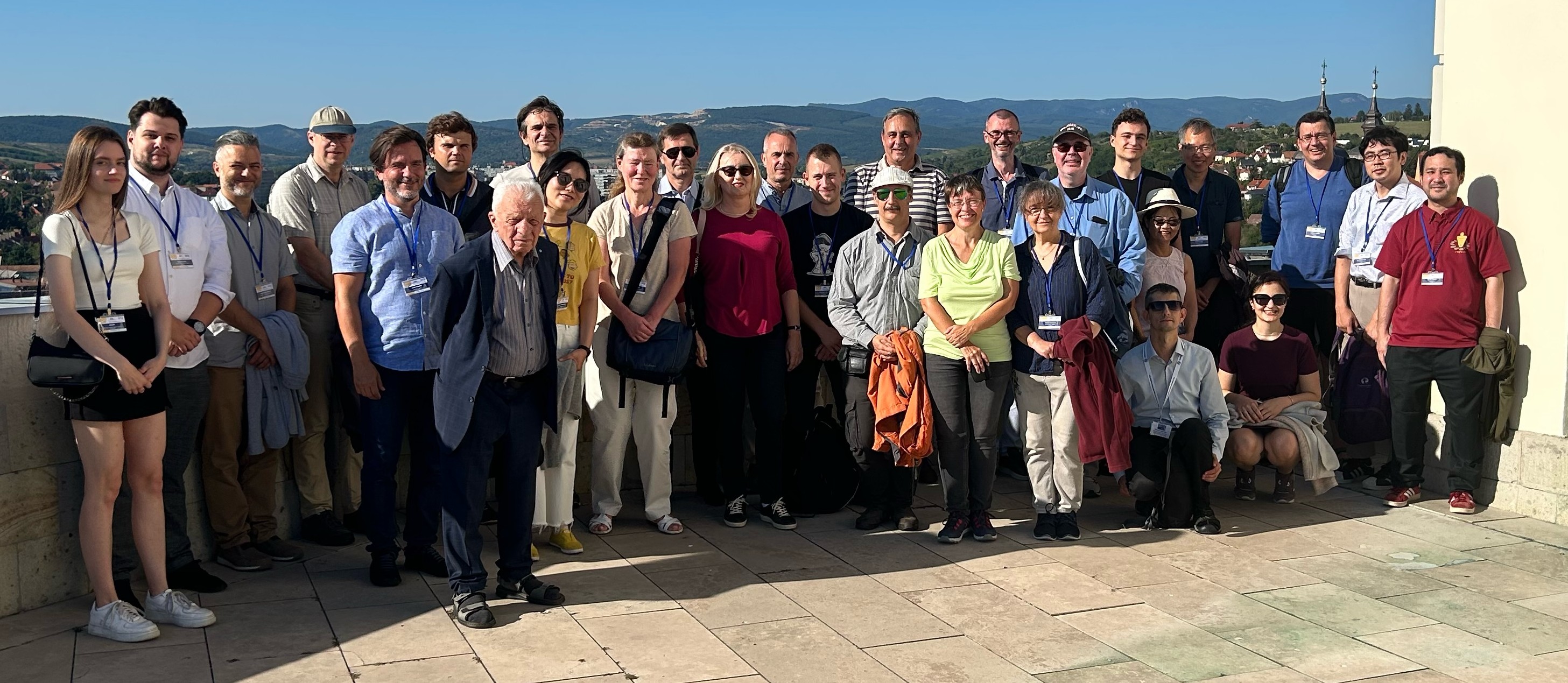AFL 2023
16th International Conference on Automata and Formal Languages
September 5-7, 2023, Eger, Hungary

Thanks!
Thanks to all the participants and the committee members for making ALF 2023 successful.
This group photo was taken on the top of the Observatory Tower of the Eszterházy Károly Catholic University of Eger.
General Information
The AFL conferences cover all aspects of automata and formal languages, including theory and applications.
The conference series was initiated by Prof. István Peák (1936-1989). He organized the AFL conferences in 1980, 1982, 1984, 1986 and 1988 and started the organization of AFL’90. These conferences were all held in the hills around Salgótarján. In 1986 and 1988, the title of the conference was Automata, Languages and Programming Systems.
Since the untimely death of Prof. István Peák, the AFL conferences have been organized in every third year. Professors András Ádám and Pál Dömösi took the lead in the continuation of the series. In 1990, 1993, and 1996, three more “Salgótarján conferences” took place. Nowadays a Steering Committee takes care of the continuation of the AFL series.
The last conferences of the series were held in Vasszécsény (1999), Debrecen (2002), Dobogókő (AFL'05), Balatonfüred (AFL 2008), Debrecen (AFL'11), Szeged (AFL 2014) and Debrecen (AFL 2017). The 2020 edition was cancelled due to the ongoing Covid-19 event.
In 2023, the conference is organized by the Institute of Informatics of the University of Szeged, and the Faculty of Informatics of the Eszterházy Károly Catholic University of Eger.
Topics
Topics of interest include (but are not limited to) the following.
- Grammars, acceptors and transducers for strings, trees, graphs, arrays, etc.,
- algebraic theories for automata and languages,
- combinatorial properties of words and languages,
- formal power series,
- decision problems,
- efficient algorithms for automata and languages.
- complexity theory and logic,
- picture description and analysis,
- quantum computing,
- cryptography,
- concurrency.
- biology,
- natural language processing,
- and other fields.
Steering Committee
- András Ádám (Budapest, honorary chair)
- István Babcsányi (Budapest)
- Erzsébet Csuhaj-Varjú (Budapest)
- Pál Dömösi (Debrecen, chair)
- Zoltán Fülöp (Szeged)
- Zsolt Gazdag (Szeged)
- László Hunyadvári (Budapest)
- Szabolcs Iván (Szeged)
- László Kászonyi (Szombathely)
- Gergely Kovásznai (Eger)
- Attila Nagy (Budapest)
- György Vaszil (Debrecen)
Program Committee
- Francine Blanchet-Sadri (UNC Greensboro)
- Henning Bordihn (Universität Potsdam)
- Miroslav Ćirić (University of Niš)
- Erzsébet Csuhaj-Varjú (Eötvös Loránd University, Budapest)
- Pál Dömösi (University of Nyíregyháza)
- Gabriele Fici (Università di Palermo)
- Zoltán Fülöp (University of Szeged)
- Zsolt Gazdag (University of Szeged, co-chair)
- Viliam Geffert (P. J. Šafárik University, Košice)
- Géza Horváth (University of Debrecen)
- Szabolcs Iván (University of Szeged, co-chair)
- Gergely Kovásznai (Eszterházy Károly Catholic University, Eger)
- Martin Kutrib (Universität Gießen)
- Andreas Malcher (Universität Gießen)
- Benedek Nagy (Eastern Mediterranean University, Famagusta; Eszterházy Károly Catholic University, Eger)
- Chrystopher L. Nehaniv (University of Waterloo)
- František Mráz (Charles University, Prague)
- Giovanni Pighizzini (University of Milan)
- Agustín Riscos-Nunez (Universidad de Sevilla)
- Kai Salomaa (Queens's University, Kingston)
- Petr Sosík (Silesian University in Opava)
- Bianca Truthe (Universität Gießen)
- György Vaszil (University of Debrecen)
- Roland Király (Eszterházy Károly Catholic University, Eger)
Invited Speakers
Galina Jírásková (Slovak Academy of Sciences, Košice): Operations on Boolean and Alternating Finite Automata
Victor Mitrana (Polytechnic University of Madrid and National Institute of R&D for Biological Sciences, Bucharest): On the Degree of Extension of Some Models Defining Non-Regular Languages
Andreas Maletti (Universität Leipzig): Compositions of Weighted Extended Top-down Tree Transducers
Paper Preparation
Submissions to AFL 2023 should not exceed 15 pages (in the EPTCS Style), including bibliography.
If the authors believe that more details are essential to substantiate the main findings of the paper, a clearly marked appendix can be additionally included that will be read at the discretion of the program committee. Upon acceptance, this appendix will not be contained in the proceedings.
Simultaneous submissions of articles to other conferences with published proceedings or submitting already published / accepted papers is not allowed.
Paper Submission
Submissions should be sent via the Easychair system through the link https://easychair.org/conferences/?conf=afl_2023.In order to participate AFL 2023, please register to the conference as soon as possible.
Registration Fee
The registration fee for a conference participant (70.000 HUF/180 EUR) covers admission to the scientific sessions, the coffee-breaks, the lunches (Tuesday-Wednesday-Thursday), the social program, and the conference dinner with wine tasting (Wednesday).
The registration fee for an accompanying person (35.000 HUF/90 EUR) covers the lunches (Tuesday-Wednesday-Thursday), the social program, and the conference dinner with wine tasting.
The registration fee is preferably to be paid by bank transfer, or at the conference site in cash.
How to Register
To register, please fill this registration form: https://forms.gle/o1ChrJ5DB815c2ZD9
How to Pay
For participants from outside of Hungary, please transmit the fee to the following bank account:
For participants from Hungary, please transmit the fee to the following bank account:
Add the conference name (AFL 2023) and your name to the description of your bank transfer!
Invoice
You will get an electronic invoice via e-mail after you paid the registration fee.
If you need a pro-forma invoice beforehand, please, let us known in e-mail to afl2023@uni-eszterhazy.hu
Accepted Papers
Elena Barcucci, Antonio Bernini, Stefano Bilotta and Renzo Pinzani. A construction for variable dimension strong non-overlapping matrices
Jason Bell, Daniel Smertnig and Hellis Tamm. Duality of lattices associated to left and right quotients
Miroslav Ćirić, Ivana Micić, Stefan Stanimirović and Linh Anh Nguyen. Approximate state reduction of fuzzy finite automata
Nada Damljanović, Miroslav Ćirić and Jelena Ignjatović. Weighted automata over vector spaces
Szilard Zsolt Fazekas and Shinnosuke Seki. Freezing 1-tag systems with states
Henning Fernau, Lakshmanan Kuppusamy and Indhumathi Raman. When Stars Control a Grammar's Work
Nataliya Gribovskaya and Irina Virbitskaite. Comparative Transition System Semantics for Cause-Respecting Reversible Prime Event Structures
Markus Holzer and Christian Rauch. On Minimal Pumping Constants for Regular Languages
Martin Kutrib and Andreas Malcher. Reversible Two-Party Computations
Andreas Maletti and Nils Oskar Nuernbergk. Pumping Lemmata for Recognizable Weighted Languages over Artinian Semirings
Benedek Nagy. State deterministic finite automata with translucent letters and finite automata with nondeterministic translucent letters
Yoshiki Nakamura and Ryoma Sin'Ya. Words-to-Letters Valuations for Language Kleene Algebras with Variable Complements
Andreea-Teodora Nász. Solving the Weighted HOM-Problem With the Help of Unambiguity
Giovanni Pighizzini and Luca Prigioniero. Once-Marking and Always-Marking 1-Limited Automata
Jeffrey Shallit and Sonja Linghui Shan. A General Approach to Proving Properties of Fibonacci Representations via Automata Theory
Nicholas Tran. Separating words from any start state with Horner automata
Bianca Truthe. Strictly Locally Testable and Resources Restricted Control Languages in Tree-Controlled Grammars
Mansur Ziiatdinov, Aliya Khadieva and Abuzer Yakaryilmaz. GAPs for Shallow Implementation of Quantum Finite Automata
Program
Proceedings
The conference proceedings is to appear in an issue of the Electronic Proceedings in Theoretical Computer Science. It is available as volume 386 in the EPTCS series:
https://cgi.cse.unsw.edu.au/~eptcs/content.cgi?AFL2023
The whole proceedings can be obtained in a single pdf file here:
https://cgi.cse.unsw.edu.au/~eptcs/Published/AFL2023/Proceedings.pdf
Special Issue
A special issue of the International Journal of Foundations of Computer Science devoted to extended versions of selected papers will be published after the conference.Venue
The conference will be held at the "C" Building of the Eszterházy Károly Catholic University.

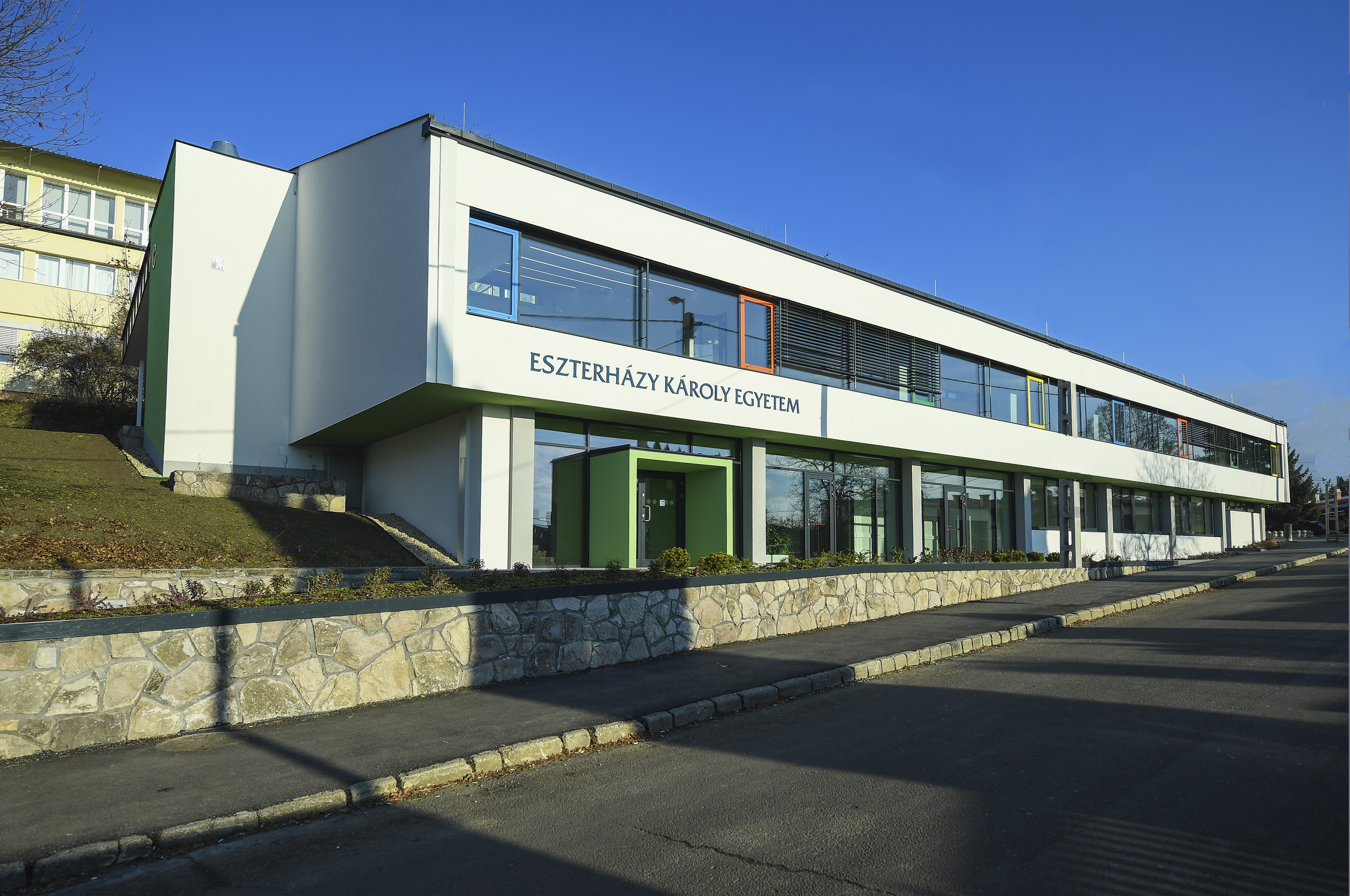
Address: H-3300 Eger, Leányka str. 4.
Location: 47.9028368, 20.3866987
Eger, the city of culture and wine
Filled with beautifully preserved Baroque buildings, Eger is a historical town with lots of things to see and do. You can explore the bloody history of Turkish occupation and defeat at the hilltop castle, climb an original Ottoman minaret, or relax in a renovated Turkish bath.

The town of Eger was built around a former cathedral, founded in the 10th century by St. Stephen, the first Hungarian king. Eger flourished during the Middle Ages when winemaking became a main source of income, but in the 16th century, under the Turkish occupation, the town changed radically. Most churches were converted into mosques and public baths, and minarets were built.
When talking about Eger, the first thing that comes to nearly all Hungarians' mind is Eger Castle, and "The Eclipse of the Crescent Moon" or "The Stars of Eger", known as Hungary's favourite novel, written by Géza Gárdonyi in 1899. The novel tells the story of two young Hungarian children, an orphan boy and a young noble girl, who are kidnapped by a Turkish slave trader, although, thanks to the cleverness of the boy, they are able to escape. Years later, the young boy must again defend the girl, already his sweetheart, from the Turks. Besides the tales of several battles, the novel details the extraordinary 1552 siege of Eger, during which Captain István Dobó's 2,000 Hungarian men, women and children inside the county's castle, defeated a Turkish force of 80,000 men. About 45 years later Eger was eventually captured by the Turks and they ruled the city for almost a century. The book provides fantastic history, entertainment and romance for kids (and grown ups) of all nationalities. To date the novel is also part of the national curriculum.
Bull's Blood
Apart from the history and architecture, there is another reason to visit Eger. Eger wine region is a Hungarian wine region in North-Eastern Hungary, on the southern slopes of the Bükk Mountains. It is famous for its red blend, Egri Bikavér (Eger Bull's Blood) and for some white wines, like Egri Leányka, Debrői Hárslevelű or Egerszáláti Olaszrizling.
The residents of the town of Eger and its surroundings have been involved in grape and wine production for almost thousand years. At the beginning of the 90s the Eger wine region went through an extraordinarily fast development. The place to visit is "Szépasszony-völgy" (the Valley of Beautiful Women), a valley just south of the city, which has many wine cellars. Visitors are welcome and wine tasting is offered in several locations. Shuttle service is available from the main square (Dobó tér).
In 2017, Eger Bull's Blood became a Hungaricum, meaning that is unique to Hungary and therefore represents great value for the Hungarians.
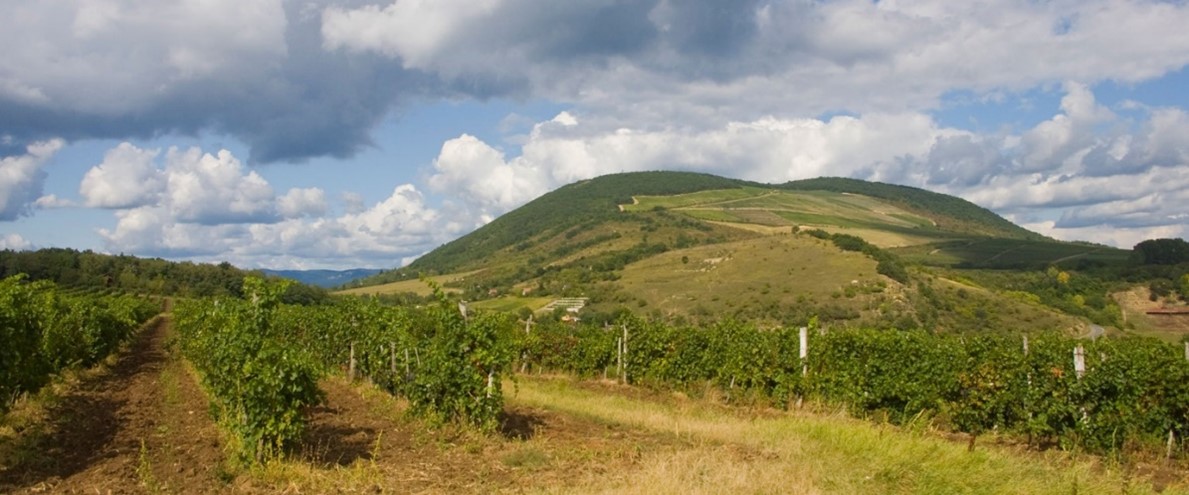
City under the city
One of the seven building wonders of Hungary. When the Turks left Eger in 1687 bishop György Fenessy returned to the city but no longer wanted to live in the castle. He purchased two lands to build a palace. To build it the stone required was mined from the hill behind the palace. So came this enormous cellar-system into being, where the tithe on the wines and the tax of the church was kept. The system runs 4km under the city. Its most beautiful part is the pillar room, where 7x7 cellar-branches meet in a chessboard-like pattern.
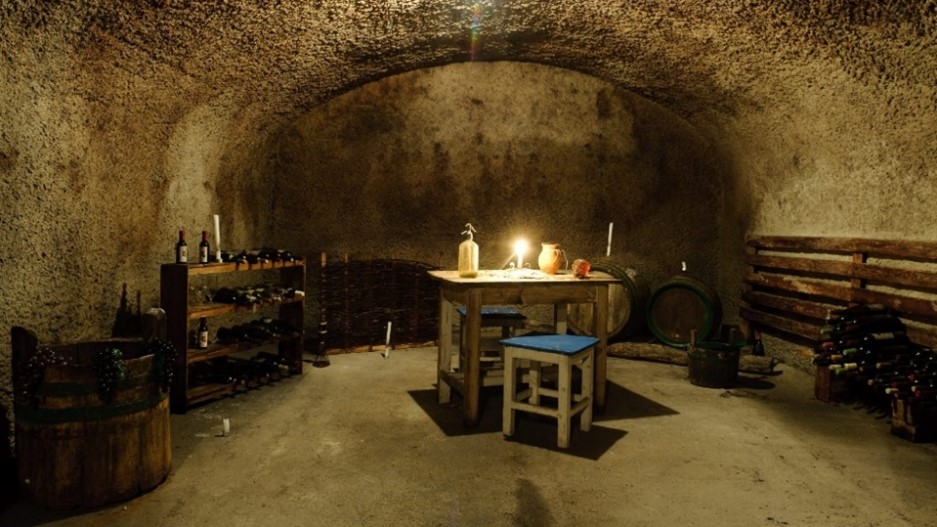
Lyceum
In the 1760s, Bishop Károly Eszterházy started to build the Lyceum for a university with faculties of philosophy, theology, law and medicine, which he called domus universitatis, university house. The Lyceum was built in the late Baroque style. The interior was designed by Jakab Fellner and was the work of craftsmen from Eger and abroad who had settled in the city. The Rococo and tufted stoves were commissioned from the master potter Károly Magner from Győr. The chapel is decorated with a monumental Baroque fresco by Franz Anton Maulbertsch.
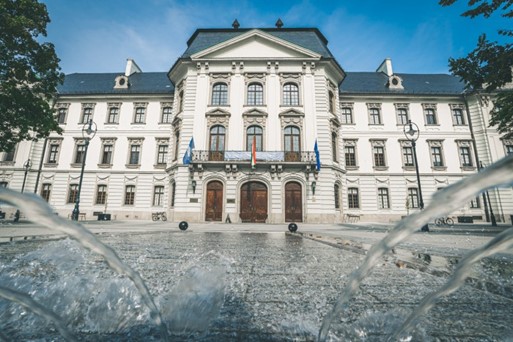
The astronomical tower of the Lyceum was designed by the renowned astronomer Miksa Hell under the direction of Károly Eszterházy. The observatory was one of the best equipped observatories in Europe at the end of the 18th century.
Observatory and Science Experience Center
The observatory in the Lyceum has the world's rarest Camera Obscura, Europe's oldest working periscope. Visitors can admire the sights of Eger from the Panorama Terrace, the highest observation tower in the city.
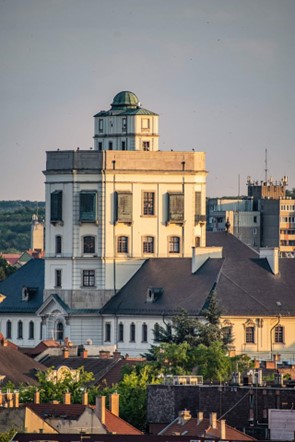
The Museum of Astronomy houses original instruments acquired by Miksa Hell, a Hungarian-born royal astronomer from Vienna. Interactive tools in the Magic Room help you understand physical phenomena in a "hands-on" way. Visitors can learn about basic physical phenomena through interesting experiments they can carry out themselves, and play scientific "games". The experiments range from mechanics, through optical instruments, to electromagnetic curiosities. The interactive experiments are suitable for all ages. The room is also home to spectacular exhibitions on astronomy, a display case on the history of space travel, a giant illuminated wall showing the most spectacular galaxies in the Universe, and a 3D Barringer grid.
Travel Information
The text presents various transportation options between Budapest and Eger, including train, bus, car, and taxi. Here's a brief summary of the key details for each mode of transportation:
By train
One option to get to Eger from Budapest is by train, which is the most common and comfortable mode of transportation. Trains depart from Budapest's Keleti Railway Station and directly arrive at Eger. The travel time is usually around 2-2.5 hours, depending on the type of train chosen.
You can purchase train tickets at the following link: https://www.mavcsoport.hu.
By bus
Another option is using bus services. In Budapest, buses to Eger only depart from the Stadionok bus terminal. The travel time is usually around 2-3 hours.
You can purchase bus tickets at the following link: https://www.volanbusz.hu.
If you are traveling to Eger by train or bus, you can plan your journey at the following link: https://menetrend.hu.
If you choose public transportation (train or bus) and want to plan your local travel in Budapest, the following options are available to get to the train or bus station:
- You can download the "Google Maps" navigation app from the Play Store.
- You can download the travel planning app "BudapestGO" from the Play Store.
- (Alternatively, you can also consider taking a taxi for a convenient and quick solution.)
By car
If you rent a car, you can easily reach Eger via the M3 motorway. The distance between Budapest and Eger is approximately 130 kilometers, and the travel time is usually 1.5-2 hours, depending on traffic conditions.
Preferred car rental companies in Budapest:
- Hertz: https://www.hertz.hu/rentacar/reservation
- Avis: https://www.avis.hu
- Europcar: https://www.europcar.com/en-us
- Budget: https://www.budget.hu
- Sixt: https://www.sixt.hu
It is important to know that there are toll roads or sections on highways in Hungary, and these need to be considered when renting a car. Please make sure to inquire before car rental if your rented car has a valid highway vignette (toll sticker). Using the toll roads without the vignette is prohibited and may result in penalties.
If you choose car rental and the car does not come with a navigation device or application, you can organize your trip using the following methods:
- You can download the "Google Maps" navigation app from the Play Store.
- You can download the "Waze" navigation app from the Play Store.
By taxi
You can choose taxi service as a comfortable and quick solution. Taxis can directly take you from Budapest Airport to Eger. It's important to note that taxi fares are generally higher compared to other transportation options.
In Budapest, you can book a taxi with the following taxi companies:
- Budapest Airport Taxi (official airport taxi service): https://www.budapestairporttaxi.com/Welcome.html
- Főtaxi (official airport taxi service): https://fotaxi.hu/en
- City Taxi Budapest: https://citytaxi.hu/en/home
- Taxify (Bolt) Budapest: https://bolt.eu/en-hu
- Uber (if available): https://www.uber.com/hu/en
In Eger, you can call a taxi using the following phone numbers or link:
- City Taxi Eger: +36 36 555-555 or https://citytaxieger.hu
- Taxi Eger: +36 80 622-555 or https://taxieger.hu
- Tourist Taxi Eger: +36 80 777-444, +36 30 3777-444, +36 30 2124-466 or https://touristtaxi.hu/kapcsolat
- Termál Taxi Eger: +36 36 353-353 or https://termaltaxieger.hu/kapcsolat
In Eger, you can use the following option for pedestrian transportation:
- You can download the "Google Maps" navigation app from the Play Store.
Accomodation Information
Participants are asked to make their own hotel reservations. Here are some hotels in the vicinity of the faculty. See the map on the bottom of the page for the hotel locations.
- Hotel Korona****
- Hotel Imola Platán****
- Hotel Eger Park****
- Hotel Szent István***
- Hotel Unicorn***
- Hotel Estella**
The following map shows the location of the hotels and the Faculty of Informatics. Click on the icon in the top-left corner to see the list of hotels, and then click on any of them for more information. There you can also check/uncheck paths from the hotels to the faculty.
Organizers
In 2023, the conference is organized by the University of Eger, and the University of Szeged.
Support
We are grateful to the Faculty of Informatics of the Eszterházy Károly Catholic University of Eger and the Institute of Informatics of University of Szeged for the local organization and financial support of AFL 2023.
Important Dates
- Submission:
May 28June 4 - Notification: July
27 - Final Version: July
931 - Registration: August
2225 - Conference: September 5-7
